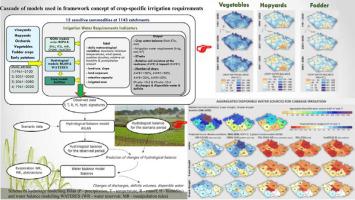Agricultural Water Management ( IF 6.7 ) Pub Date : 2021-11-17 , DOI: 10.1016/j.agwat.2021.107337 V. Potopová 1, 2 , M. Trnka 2 , A. Vizina 3, 4 , D. Semerádová 2 , J. Balek 2 , M.R.A. Chawdhery 1 , M. Musiolková 1 , P. Pavlík 3, 4 , M. Možný 1, 2 , P. Štěpánek 2 , B. Clothier 5

|
This study quantified the crop water consumption, crop-specific irrigation requirements, and availability of water resources to catchments under climate change in the Czech Republic (CZ). Within the SoilClim model and BILAN-WATERES hydrological water balance modeling process, we tried to answer the question of whether there are at least theoretical water resources in the individual catchments of the CZ that could cover possible higher demands for irrigation. An ensemble of five global climate models under the moderate representative concentration pathway (RCP4.5) from the EURO-CORDEX initiative was chosen to project the future water use indicators. The irrigation water requirement indicators for the growing season (GS) of vineyards, hop gardens, orchards, vegetables, and fodder crops were calculated in 1143 catchments for two periods, 2031–2050 (Sc1) and 2061–2080 (Sc2), compared to the observed period 1961–2020 (Obs). To project irrigation scenarios in agricultural water management, the following water use indicators were quantified: relative soil moisture at 0–40 cm (AWR1) and 0–100 cm (AWR), crop water balance (Rain-ETa), irrigation water requirement (Irrig), and the ratio of actual and reference evapotranspiration (ETratio). To assess areas with a critically low water supply and quantify the frequency of water deficit during the GS of each crop, we calculated the number of days with extreme values of water use indicators. Quantification of the extreme irrigation characteristics reflected the highest depletion of soil moisture and the highest water demands, i.e., when the assessed indicators reached the 25th percentiles. For highly marketable vegetables, the largest deficit in Rain-ETa during the GS for Sc1 was projected. If current vegetable growing areas and cropping systems remain unchanged, Irrig will increase by 10.2% by the end of the 21st century under RCP4.5. Although current potato planting areas have soils with a high available water capacity, they will become controlled by the water deficit over the next few decades. The accumulated vineyard water required suggests that 15% and 25% of irrigation water will be lost by evaporation from the soil surface during the 2030s and 2080s, respectively. However, changes in future hopyard irrigation extent and amounts may have important implications in largely cropped irrigation hotspots. In the main traditional hop region for the 2030s, we project a 25% depletion of soil moisture and an increase of ETratio < 0.4 by up to 5.3%. The projection of a high frequency of days with an ETratio < 0.4 and AWR1 < 30% for fodder crops was related to the most risk-prone areas with an extreme lack of moisture in the regions with the most developed animal production. Thus, there will be insufficient fodder supply to the livestock sector due to any water stress during the production season under climate change conditions.
中文翻译:

捷克共和国敏感农作物商品的 21 世纪灌溉用水需求预测
本研究量化了捷克共和国 (CZ) 在气候变化条件下的作物用水量、特定作物的灌溉要求以及集水区水资源的可用性。在 SoilClim 模型和 BILAN-WATERES 水文水平衡建模过程中,我们试图回答在 CZ 的各个流域中是否至少存在理论水资源可以满足可能更高的灌溉需求的问题。选择了来自 EURO-CORDEX 倡议的中等代表性浓度路径 (RCP4.5) 下的五个全球气候模型的集合来预测未来的用水指标。计算了两个时期1143个流域的葡萄园、啤酒花园、果园、蔬菜和饲料作物生长季(GS)灌溉需水指标,2031–2050 (Sc1) 和 2061–2080 (Sc2),与观察到的 1961–2020 (Obs) 时期相比。为了在农业用水管理中预测灌溉情景,量化了以下用水指标:0-40 厘米的相对土壤湿度(AWR1 ) 和 0–100 cm ( AWR )、作物水分平衡 ( Rain-ET a )、灌溉需水量 ( Irrig ) 以及实际和参考蒸发量的比率( ET ratio )。为了评估供水严重不足的地区并量化每种作物 GS 期间缺水的频率,我们计算了用水指标极值的天数。极端灌溉特征的量化反映了土壤水分的最高消耗和最高的需水量,即当评估指标达到第 25 个百分位数时。对于畅销蔬菜,Rain-ET的最大赤字a在 Sc1 的 GS 期间被预测。如果目前的蔬菜种植面积和种植制度保持不变,在RCP4.5下,到21世纪末灌溉量将增加10.2%。尽管目前马铃薯种植区的土壤具有高可用水容量,但在未来几十年它们将受到缺水的控制。所需的葡萄园积水表明,在 2030 年代和 2080 年代,土壤表面蒸发将分别损失 15% 和 25% 的灌溉水。然而,未来啤酒花灌溉范围和数量的变化可能对大量种植的灌溉热点产生重要影响。在 2030 年代的主要传统啤酒花地区,我们预计土壤水分消耗 25%,ET比率增加 < 0.4高达 5.3%。饲料作物ET比 < 0.4和AWR1 < 30%的高频率天数预测与最易发生风险的地区有关,在动物生产最发达的地区,水分极度缺乏。因此,在气候变化条件下,生产季节期间的任何水资源压力都会导致畜牧业的饲料供应不足。


























 京公网安备 11010802027423号
京公网安备 11010802027423号